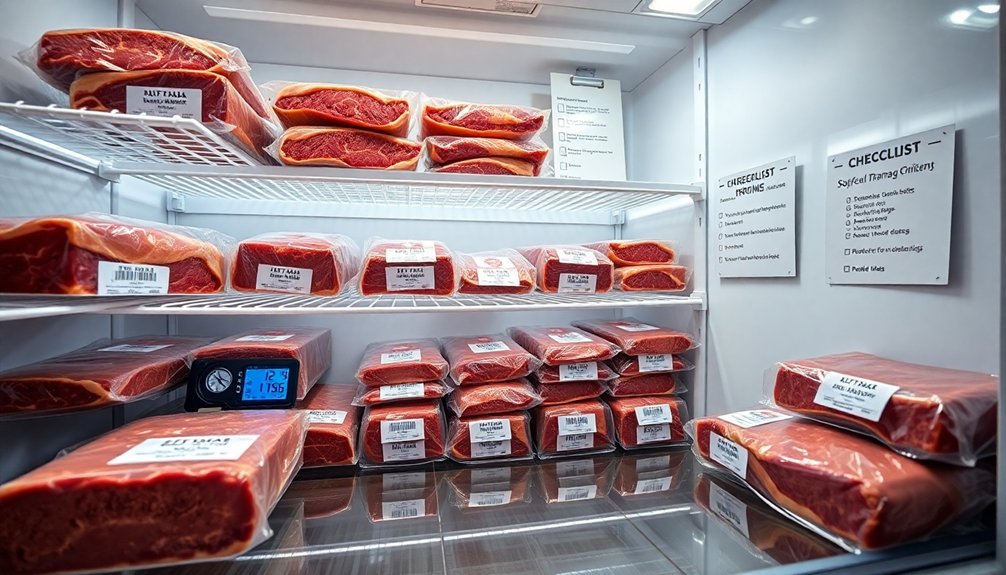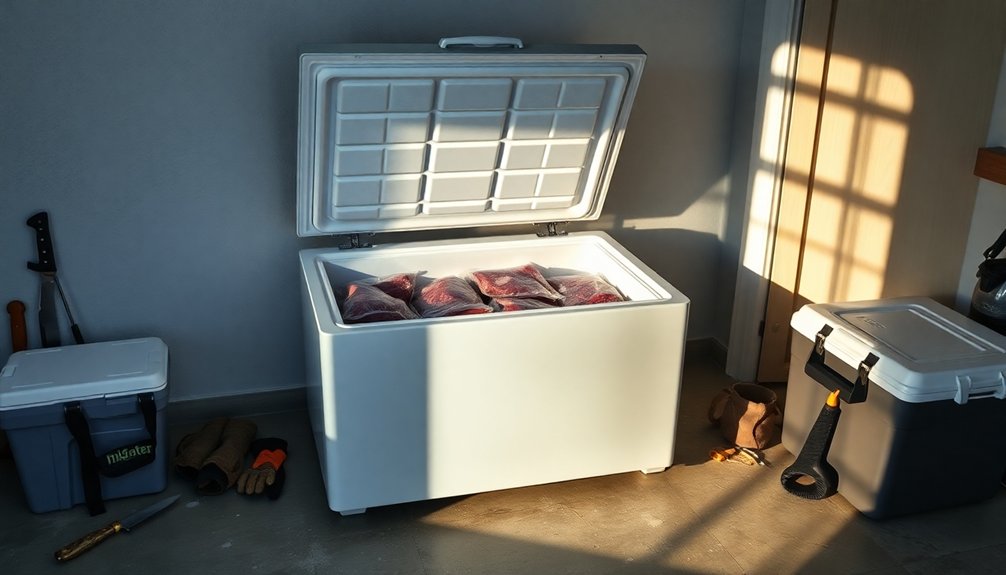To effectively store deer meat, consider your needs carefully. A 3.5 cu ft freezer fits a large deer, while a 7 cu ft model holds meat from two deer. For larger game, a 10-12 cu ft chest freezer is ideal, accommodating more meat efficiently. If you’re processing multiple deer, a 14 cu ft upright freezer can manage up to six. Selecting the right size guarantees peak preservation of quality and safety. Discover more insights on maximizing your freezer’s potential.
Recommended Freezer Sizes for Deer Meat
When it comes to storing deer meat, choosing the right freezer size is essential for maintaining quality and preventing spoilage.
A 3.5 cu ft chest freezer can accommodate a large deer, while a 7 cu ft model is better suited for storing meat from two deer.
If you frequently hunt elk or larger game, consider a 10-12 cu ft chest freezer or a 14 cu ft upright freezer for ideal storage.
For those who hunt multiple large animals, a 12 cu ft chest freezer can hold both a deer and an elk.
For long-term storage, larger freezers, particularly those over 15 cu ft, provide ample space not only for deer and elk but also for other meats and items. Additionally, investing in a freezer can be a part of sustainable and ethical shopping practices that reduce waste and promote conscious consumerism.
Types of Freezers for Optimal Storage
Choosing the right type of freezer can greatly impact how well you store deer meat.
Chest freezers are often favored for their capacity to maintain temperature longer during power outages and maximize packing efficiency. A 7 cu ft chest freezer can hold about 2-3 deer’s worth of processed meat, making it ideal for bulk storage.
On the other hand, upright freezers offer better organization and accessibility, allowing you to locate specific items easily. A larger 14 cu ft upright freezer can accommodate up to six deer, catering well to frequent access.
Using both types simultaneously can meet diverse storage needs, with chest freezers being more energy-efficient for long-term storage while upright models facilitate quick retrieval of items. Additionally, understanding investment diversification can help you make informed decisions about purchasing the right freezer based on your storage needs and budget.
Space Management Tips for Freezer Organization

Effective space management in your freezer is vital for preserving deer meat while optimizing accessibility.
Using bins or crates in chest freezers can considerably enhance organization, preventing items from being buried or lost. For upright freezers, wire baskets work well to separate various meat types, maximizing visibility and ease of access.
To fill extra space efficiently, consider using bags of ice, which also help maintain temperature stability.
It’s essential to label packages with contents and dates, allowing you to track what’s stored and when it should be used, thereby reducing spoilage risks. Additionally, utilizing expense management apps can assist in budgeting for your meat storage needs.
Finally, regularly monitor and rotate your freezer contents to guarantee older items get used first, promoting an efficient storage system and minimizing waste.
Importance of Proper Cold Storage for Meat Quality
Proper cold storage plays a significant role in preserving the quality of deer meat, as it directly affects the meat’s flavor, tenderness, and safety. By maintaining ideal aging temperatures in the high 30s Fahrenheit, you prevent spoilage and inhibit harmful bacteria growth.
Freezing meat halts biological aging processes, ensuring it retains its rich flavor and tenderness until you’re ready to consume it. It’s essential to store deer meat in adequately cold environments immediately after processing, as temperatures above 40°F can lead to rapid spoilage.
Additionally, aging meat in a controlled environment enhances its quality by allowing enzymes to break down undesirable compounds, while stable temperatures and controlled humidity help prevent bacterial growth, ensuring highest meat quality. Implementing expense categorization methods can help streamline your food storage budget, ensuring you have the resources to maintain proper cold storage.
Future Storage Considerations Beyond Deer Meat

While it’s essential to select a freezer that meets your immediate deer meat storage needs, considering future requirements can greatly enhance your investment.
Here are three important factors to address:
- Freezer Size: Opt for a larger model, like a 15 cu ft upright, to accommodate various meats and items beyond deer, ensuring versatility.
- Additional Storage: Plan for future needs by accounting for items like ice cream, fish, or seasonal produce, preventing the need for another freezer.
- Hunting Success: If you anticipate processing multiple deer, consider a 10-12 cu ft chest freezer to handle the expected volume efficiently. Additionally, having a larger freezer allows for automated tasks related to food storage, ensuring more efficient organization of your items.
Conclusion
In conclusion, securing sufficient space for storing succulent venison is essential for maintaining meat quality and freshness. A spacious, suitable freezer not only safeguards your supply but also simplifies storage solutions. By selecting the right type of freezer and utilizing smart space management strategies, you can guarantee your deer meat remains delicious and delightful. As you consider future storage needs, remember that proper cold conditions create a foundation for food safety and flavor preservation.



